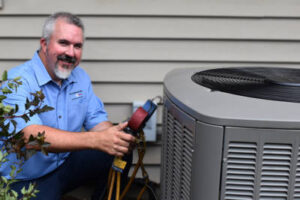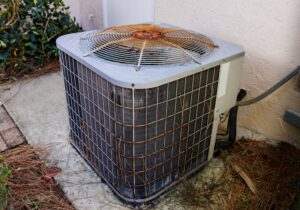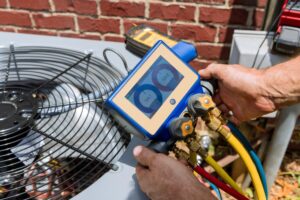Summers in Burlington, WI, and the surrounding areas can be brutal when it comes to heat and humidity. Luckily, we have air conditioners to help keep us cool all summer long. But our question to you is: Do you know how this machine works?
Many people might be surprised to learn that an air conditioner doesn’t technically create cool air. Instead, it moves warm air from your home to the outdoors. How exactly does this process work? It involves a fascinating interplay between several key components.
Air Conditioning History
Let’s take a closer look at the background of air conditioners before we get into the specifics of how one of these units works. Willis Carrier invented the first modern air conditioning system in 1902. His invention led to amazing feats in other industries, including increased production in manufacturing and enabling the start of summer movie blockbusters (as people flocked to theaters to escape the heat). It quickly became clear that precisely controlling indoor temperatures and humidity offered great advantages like increased productivity, more pleasant employees, and enhanced comfort.
While the air conditioning industry has evolved since its beginnings in 1902, the principles of how an air conditioner works are mostly the same. Let’s take a closer look at how a modern AC system works.
How an Air Conditioner Works
As we mentioned earlier, AC systems work by transferring heat from one area to another. Once the heat is removed, the cold air is pumped through your home. To accomplish the transfer of heat, the system has several components that must work together, including the compressor, condenser, metering device, and evaporator coil.
Compressor
The compressor is sometimes referred to as the heart of the system. Your air conditioner pumps refrigerant through the compressor to cool your home. Refrigerant enters as a gas and becomes compressed with increased pressure and temperature. By the time it leaves, it is extremely hot and under high pressure.
Condenser
The hot gas moves into the condenser coil. A fan blows air over the coil to cool the refrigerant and allow it to condense into a liquid. The compressor and condenser steps happen inside your outdoor unit.
Metering Device
After the liquid refrigerant leaves the condenser, it passes through a metering device that controls its flow to the evaporator. This changes the refrigerant from high to low pressure.
Evaporator
The evaporator coil uses the hot air from your home to heat the refrigerant until it boils and changes back into a vapor (or gaseous state). This absorption of heat leaves the air around the coil cold. The vapor then returns to the compressor.
The evaporator is located inside your home in the air handler. This handler blows hot air over the evaporator coil and then blows the cooled air through your home’s air ducts. The air handler is part of your furnace, and the evaporator will sit on top of it. One (or more) thermostats control the cooling system, adjusting the system settings and turning it on and off as the temperature in the room changes.
Types of Air Conditioners
You’ve likely heard there are different types of air conditioners — for example, you know that a ductless system is different from a central air conditioner — so you may be wondering if there are any differences between how the units work. While the core functionality remains the same, there are slight differences that allow the units to suit various needs. Here are some of the most common types of AC systems:
- Split-System Air Conditioners: These are the most common type, consisting of an indoor unit (housing the evaporator coil and blower fan) and an outdoor unit (housing the compressor and condenser coil). They are connected by refrigerant lines.
- Packaged AC Systems: These self-contained units house all the components (compressor, evaporator coil, condenser coil, and blower fan) in a single outdoor cabinet. They are often used in commercial settings or for heating and cooling smaller spaces.
- Ductless Systems (Mini-Splits): These consist of a single outdoor unit connected to multiple indoor units (each with its own evaporator coil and blower fan). This allows for independent temperature control in different zones of a home or building, making them ideal for multi-level spaces or areas without existing ductwork.
Tips for Ensuring Your Air Conditioner Works Efficiently
Just like any machine, regular maintenance is the key to keeping your air conditioner running smoothly and efficiently. Follow these simple maintenance tips so you can breathe easy all summer long:
- Schedule regular tune-ups: A professional AC maintenance technician can inspect your system, clean components, and identify potential problems before they become major issues.
- Change air filters regularly: Dirty air filters restrict airflow, reducing efficiency and cooling capacity. Aim to change or clean your air filters according to the manufacturer’s recommendations, typically once a month.
- Keep the outdoor unit clear of debris: Leaves, twigs, and other debris can obstruct airflow through the condenser coil, hindering heat dissipation. Regularly clear any obstructions around the outdoor unit.
- Set the thermostat strategically: Don’t overwork your AC! Setting your thermostat a few degrees higher can significantly reduce energy consumption without sacrificing comfort.
Enhance Your AC’s Performance Today
As you can see, your AC is a complex machine with many components that have to work together to properly cool your home. By understanding how an air conditioner works and taking steps to maintain it properly, you can enjoy a cooler home even on the hottest days.
If you’re looking for expert assistance with your air conditioning system, whether it’s a routine tune-up, mini-split repair, or installation of a new system, H.J. Faust, Inc. is here to help! We are a trusted leader in heating and cooling in Lake Geneva, WI, and the surrounding areas. Our certified technicians are dedicated to providing exceptional service, so contact us today to schedule an appointment and keep your cool all summer long!



